|
| |
Grounds/Reasons for
Written Questions
Chapter
8. The U.S. Central Bank, namely the
U.S. Federal Reserve, has provided an
annual written report to the U.S. Congress on
the Profitability of Credit Card Operations of
"large U.S. Credit Card banks"
for the last
26 years
A simple 'pie chart' for Revenue and Costs tells a lot
Over 5,000
'Depository Institutions' in the USA, including commercial banks, credit unions
and savings institutions, issue VISA and MasterCard credit cards.
In June 2012, the
U.S. Federal Reserve submitted its 25th annual written
"Report to the U.S. Congress on the Profitability of Credit Card Operations of
Depository Institutions" [12 pgs] which
"limits its focus to the 14 credit card banks
that have at least $200 million in assets".
For the last 26 years the U.S. Central
Bank has provided a written annual report to the U.S. Congress
on the Profitability of
Credit Card Operations of major Depository Institutions which
"...accounted
for approx 66 percent of outstanding credit card balances on the books of
commercial banks or in pools underlying securities backed by credit card
balances."
The U.S. Federal Reserve's annual
Report to the Congress
on the Profitability of Credit Card Operations of Depository Institutions - June 2016
includes the below Table 2 which
shows that 'USA Credit Card Banks' in 2015 had Net Interest Income of 8.73% and
Net Non-Interest Income of -1.94% of average quarterly assets.
USA Credit Card Banks are defined as commercial
banks with average assets greater than or equal to $200 million with minimum 50
percent of assets in consumer lending and 90 percent of consumer lending in the
form of revolving credit.
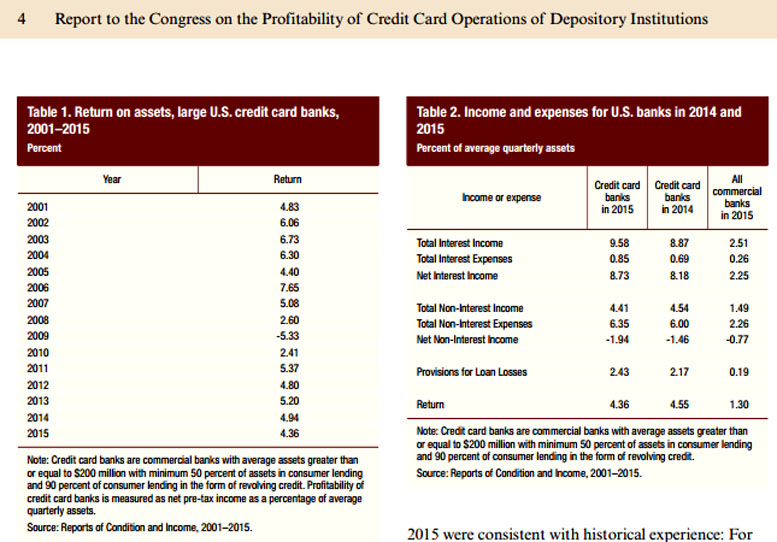
|
The below two 'pie charts' appears in a journal report titled
"Who Pays for Credit Cards?"
dated 2001 which displays a break-up of
Card Issuers' Revenues for the
aggregate of Visa, MasterCard and Discover Credit Cards in the USA. It shows
that U.S. Interest Revenues of 75% and associated Penalty Fees Revenue (Late
Payment Fees and
Overlimit Fees)
of 6.3% and Cash Advance Fees of 5.4% aggregate to 86.7% of U.S. Card Issuers' Annual Revenue.
Interchange Fees charged to Merchants were only 10.7%.
 |
'Chargeoffs' are bad debts written-off or
sold to a collections agency.
It is a sad reflection of any unsecured personal loan lending product
that almost one third of operating 'Costs' is debt written off annually.
No other lending
product could survive with writing off one third of lent money annually.
This lending product can only be maintained because of the extraordinary
quantum of interest/fees based revenue stream evident in below Revenues
'pie chart'. |
|
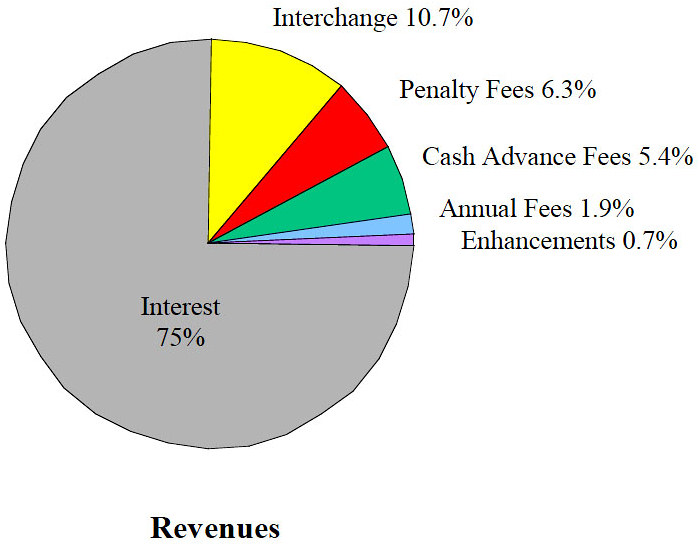 |
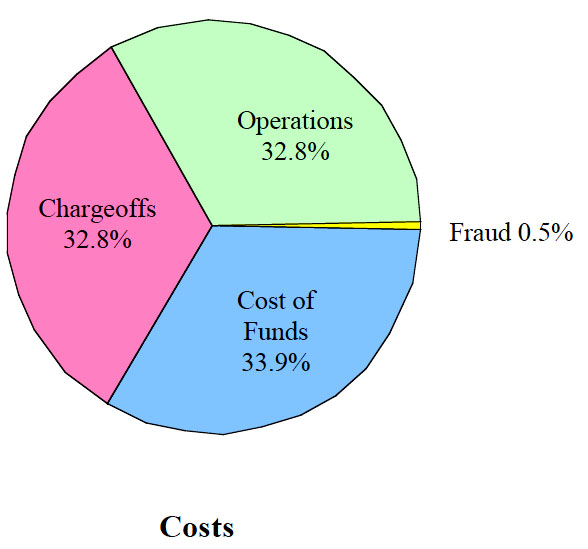 |
|
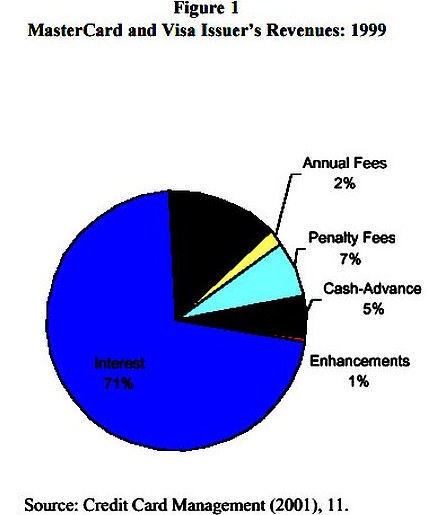 |
Below are extracts from 'Estimating
the Volume of Payments-Driven Revenues' dated 2003 published by
POLICY STUDIES presented by
Federal Reserve Bank of Chicago which relate to Figure 1 on LHS that breaks up
the revenues from US Banks that issued Visa and MasterCards in 1999:
"...... the major credit card issuers
(Visa, MasterCard) have been able to discern the percent of revenue earned from
different payments-related credit card services.
Credit Card Management (2001) breaks
down the 1999 revenues of Visa and MasterCard issuers into six subcategories:
interchange fees, annual fees, penalty fees, cash-advance fees, enhancements,
and interest. We consider interchange fees, annual fees, and enhancements to be
payments-related revenues. Based on this figure, 14 percent of total MasterCard
and Visa issuer revenues come from interchange fees, another 2 percent from
annual fees, and 1 percent from enhancements."
The pie chart shows that net U.S. Interest Revenues from Credit Cards of 71%, Penalty
Fees Revenue (Late
Payment Fees and
Overlimit Fees)
of 7% and Cash Advance Fees of 5% aggregate to 84% of U.S.
Card Issuers' Annual Revenue. Interchange Fees
charged to Merchants are only 14. Notwithstanding that
Interchange Fees are levied at a materially
higher amount in the USA,
Interchange Fees account for
less than 11% of aggregate U.S. Card Issuers' Revenue in the first above
pie-chart.
|
|
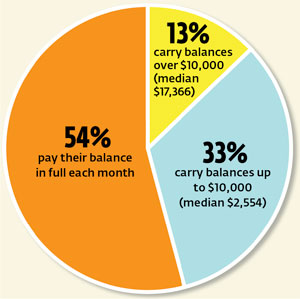
"A
third of Americans do not own a credit card, according to our
survey. Of those who use them, here's how much money they owe"
|
|
The disturbing disclosure from the above two 'Revenue' pie
charts is that the aggregate of Interest, Cash Advance Fees, and Penalty Fees
(Late Payment and Overlimit) aggregate from a high of 86.7% down to 84% of aggregate
Credit Card Issuers 'Revenue'.
Annual Fees do not exceed 2% of 'Revenue' in either above pie chart.
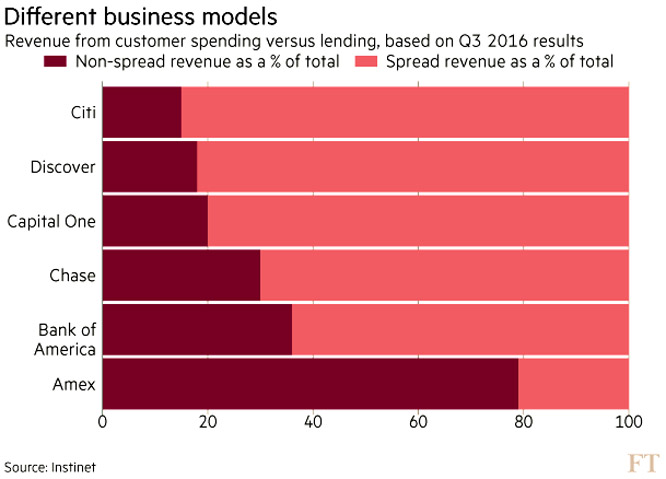
The above graph appeared in the
USA
Financial Times on Dec. 23, 2016 article discussing credit cards. One of the
charts (“Different business models”) shows a breakdown of spread revenue vs.
non-spread revenue for six major Credit Card Issuers in the USA.
Patently the top five Credit Card Issuers are deriving "The Lion's Share" of Revenue from the implicit
interest margin between "where they borrow money and the interest rates they
charge out" on
Purchases and Cash Advances on some credit cards.
Fee
income is relatively minor, except for Amex, BoA and perhaps Capital One.”
Section 8 of the Fair Credit and Charge Card Disclosure Act of 1988 directs the
U.S. Federal Reserve Board to transmit annually to the U.S. Congress a written
report about the profitability of credit card operations of depository
institutions. Last August the
Board of Governors of the
Federal Reserve System presented its 26th "Report
to the Congress on the Profitability of Credit Card Operations of Depository
Institutions".
The Reserve Bank's webpage "Accountability"
provides a section titled 'Accountability to Parliament' which notes that the
Governor of the Reserve Bank has provided every few years since 1998 to the Commonwealth Parliament a Statement on the
Conduct of Monetary Policy.
A precedent is therefore in place with the U.S. Federal Reserve reporting
annually in writing to the U.S. Congress on various aspects of Credit Cards
Profitability, for the Reserve Bank to similarly report annually to the
Commonwealth Parliament on various aspects of Credit Cards profitability which
would include Credit Card Issuers complying with
Section 3.4.8
Changes to benchmark compliance.
=====================================================================================
Refer:
Chapter
9.
Summary Page re Written Questions and the Grounds/Reasons
Grounds/Reasons
(one document with 21 Chapters)
Grounds/Reasons
(21 separate Chapters)
Written Questions
(one document with Written Questions)
Written Questions
(Individual Written Questions)
| |
|





